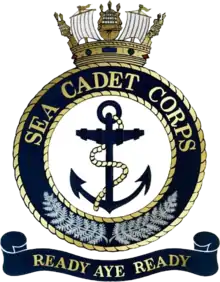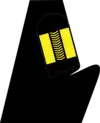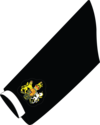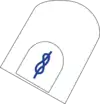New Zealand Sea Cadet Corps
The Sea Cadet Corps (also known as Navy Cadets, SCC, and Sea Cadets) is a branch of the New Zealand Cadet Forces. It is a military-style training organisation for young people between the ages of 13 and 21. It is divided into three areas with 16 units in total. Activities include sailing, and boat work, ropework shooting and drill, amongst other activities, many of which involving the other branches of the NZCF. Cadets need to pass an annual swimming test to undertake water-based activities.[1]
| New Zealand Sea Cadet Corps | |
|---|---|
 Sea Cadet Corps Crest | |
| Active | 1929 – present |
| Country | |
| Allegiance | HM The Queen |
| Branch | New Zealand Cadet Forces |
| Type | Volunteer Youth Organisation |
| Nickname(s) | Navy Cadets |
| Motto(s) | Ready, aye ready. |
| Boats Operated | |
| Commanders | |
| Chief of Defence Force | Air Marshal Kevin Short |
| NZCF Commandant | Commander Andrew Law, RNZN |
| NZCF Executive Officer | Squadron Leader Bruce Sinclair, RNZAF |
| NZCF Assistant Commandant | Wing Commander Andrew Horst, NZCF |
| Insignia | |
| Logo |  |
History
The SCC traces its roots back to 1929 when the first open Sea Cadet unit was formed in Christchurch, by the Canterbury Navy League. Units formed in the four main centres and were controlled nationally by the Canterbury branch of the League.
Organisation
National
The SCC, as a component of the New Zealand Cadet Forces, is managed at a national level by the Commandant NZ Cadet Forces (usually a Regular Force Lieutenant-Colonel or equivalent), who is part of Headquarters New Zealand Defence Force staff in Wellington. At community level, The SCC are represented by the Sea Cadet Association of New Zealand.
Area
The country is divided up into 3 areas, Northern (Northern half of the North Island), Central (Southern half of the North Island) and Southern (entire South Island). Each area has a NZCF Training and Support Unit, commanded by an Area Co-ordinator, with Advisors for SCC units. These units are operated as local headquarters for each area.
Unit
Each unit is managed by the Cadet Unit Commander, and his/her officers. There are sixteen Sea Cadet Units (also known as Training ships) across New Zealand.
Membership
Cadet Members
Cadets can join if they are between the ages of thirteen and sixteen. The units provide uniforms, but may hold bonds to ensure that they are returned. Fees are charged by each unit annually and vary between NZ$10 and $250. Certain activities may incur additional charges, although sponsorship is sometimes available.[2]
Cadets may in time be promoted to Non-commissioned officer (NCO) ranks, which are based on the rank structure of the Royal New Zealand Navy. New members are referred to by the rank of "New Entrant", before progressing to "Ordinary Cadet", then "Able Cadet", which are awarded following the completion of a test administered by the unit. Ranks above this (in order: "Leading Cadet", "Petty Officer", "Chief Petty Officer", "Warrant Officer" and "Under Officer") are only awarded after the completion of joint training courses held with other units of the Sea Cadets, as well as the Air Training Corps and New Zealand Cadet Corps. Cadet ranks are often abbreviated by omitting the "Cadet" suffix.
Cadets above the age of eighteen are considered "Adult Cadets", and still hold their respective ranks, however are required to take duty of care of younger cadets.
Adult Members
Adult Members can serve in two capacities: Commissioned Officers or Civilian Instructors. Officers are commissioned into the New Zealand Cadet Forces, with the post-nominal letters NZCF, at the rank of Ensign, and can be promoted to Sub-Lieutenant and Lieutenant, after completing the necessary training and service. The highest rank attainable is Lieutenant Commander, which is available only to Unit Commanders. Civilian Instructors are civilians who help train cadets. They do not wear uniform, but they are generally treated similarly to officers by cadets.
Activities
Parade Nights
Every unit holds Parade Nights around 2–3 hours long weekly during school terms. Each parade night usually begins and ends with a parade. The starting parade is used to inspect uniforms, and to inform the cadets on the parade night's activities. The final parade to inform the cadets on upcoming events in the unit. Between the parades, the cadets undergo classroom, or practical instruction.
Shooting
Units conduct regular range training with smallbore rifles. Some units have their own armouries and ranges at their parade hall. Cadets must pass a TOETS (Test of Elementary Training Skills) before being allowed on the range. Each year the Smitt Trophy shooting competition is held between all the Sea Cadet Units in New Zealand.
Boat work & Rigging
Develop and maintain safe seamanship skills in power, sail, oar, and paddle craft, and learn the correct way to utilise ropes and pulleys. Each unit has and operates 2 Crown's, 2 RS Feva's, and various support vessels.
Other Activities
- Drill
- History of RNZN
- Dress and bearing
- First Aid
- Navigation
- Radio procedures
Courses
Tri-Corps Courses
- Junior NCO Course
- Senior NCO Course
- Warrant Officers Course
- Under Officers Course
- Cadet Bushcraft Course
SCC Courses
- Cadet Sailing Charge Course
- Sea Time
Competitions
- Area Sea Cadet Skills (also known as Area Regatta)
- National Sea Cadet Skills (also known as National Regatta)
| Year | Area Regatta Winner | National Regatta Winner | National Regatta Location | ||
|---|---|---|---|---|---|
| Northern | Central | Southern | |||
| 2019 | Nil | TS Achilles | Tamaki Leadership Centre | ||
| 2018 | TS Achilles | TS Taupo | TS Talisman | TS Achilles | Wellington |
| 2017 | TS Bellona | TS Taupo | TS Talisman | TS Bellona | Tamaki Leadership Centre |
| 2016 | TS Leander | TS Taupo | TS Talisman | TS Talisman | Tamaki Leadership Centre |
| 2015 | TS Leander | TS Taupo | TS Talisman | TS Taupo | Wellington |
National Efficiency Competition
Each year, the Sea Cadet Association of New Zealand (SCANZ) holds a competition for the most efficient unit in the country. Each area (Northern, Central and Southern) selects one unit. Then a naval officer inspects each of the three units chosen and selects a final winner. The winning unit keeps the trophy for a year, and earns a placement for one cadet aboard the sail training ship Spirit of New Zealand.
Rank Structure
The rank structure follows the Royal New Zealand Navy[3]
Commissioned Officers
|
Non-commissioned Officers and Ratings
|
See also
Sea Cadets
- International Sea Cadet Association
- United Kingdom Sea Cadet Corps
- Other nations' Sea Cadet Corps
Navy League
References
- "Sea Cadet Corps". New Zealand Cadet Forces. Retrieved 13 April 2018.
- "Join cadet forces". New Zealand Cadet Forces. Retrieved 13 April 2018.
- "Cadet Force Orders" (PDF). CadetNet. Retrieved 20 October 2020.
External links
- Training Ship Taupo Mana, Porirua Sea Cadet Unit.
- Training Ship Achilles Central Auckland Sea Cadet Unit.
- Training Ship Leander North Shore, Auckland Sea Cadet Unit.
- Training Ship Waikato Hamilton & Waikato Sea Cadet Unit
- Training Ship Talisman Nelson Sea Cadet Unit.
- International Sea Cadet Association
- New Zealand Cadet Forces Web Site
- www.seacadets.co.nz Training Ship Tutira (Levin)








_W1.png.webp)



















